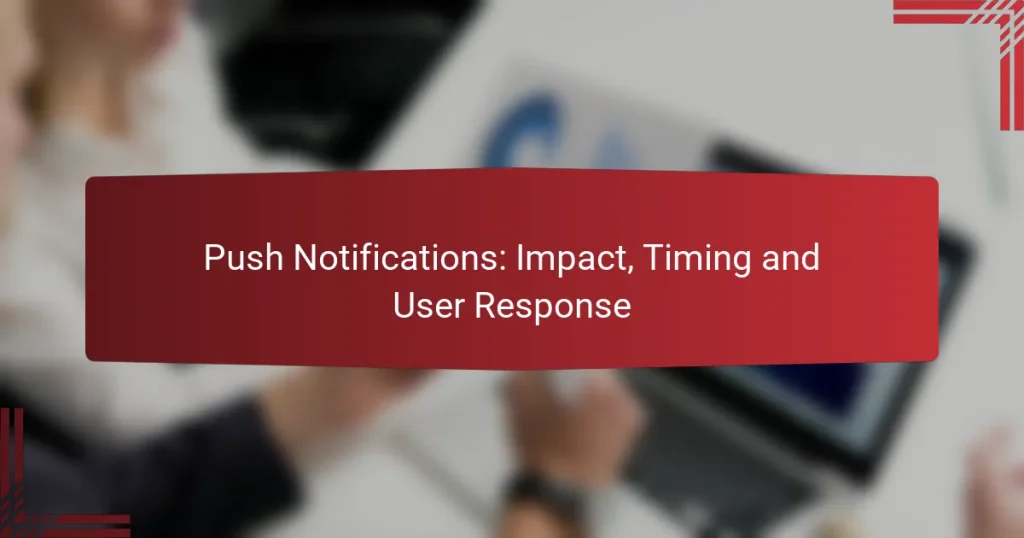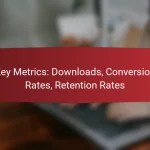Push notifications play a crucial role in boosting user engagement by providing timely and relevant information directly to users. The effectiveness of these notifications is influenced by factors such as timing, user behavior, and message personalization, which can significantly enhance interaction and retention rates. By understanding how users respond to notifications, businesses can optimize their strategies to improve overall user experience.
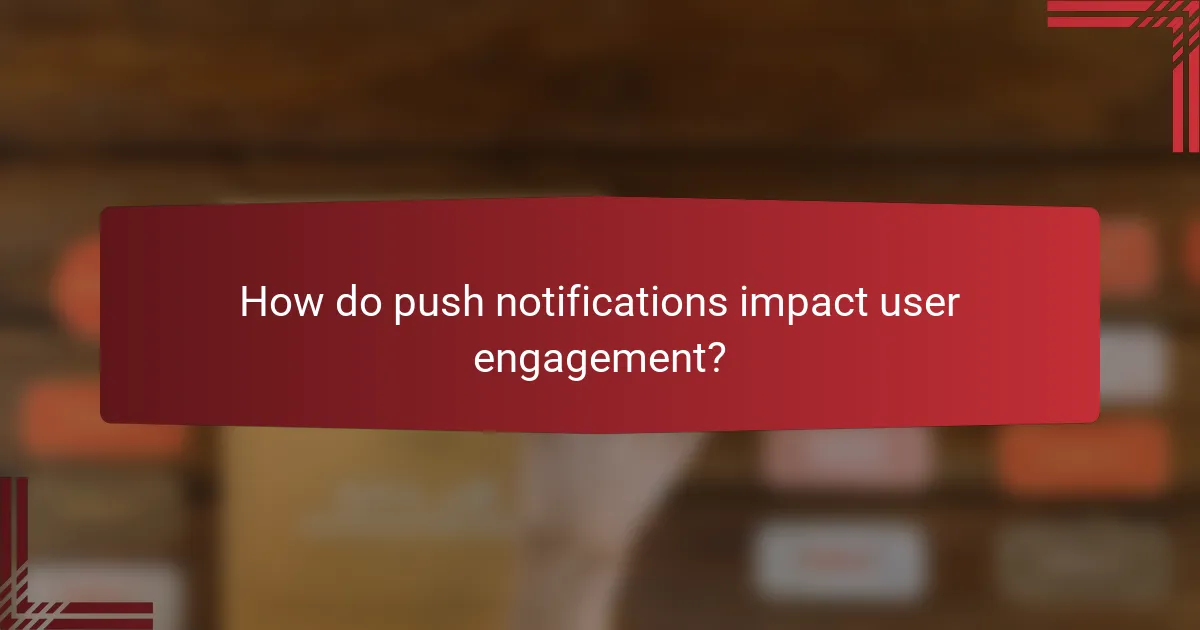
How do push notifications impact user engagement?
Push notifications significantly enhance user engagement by delivering timely and relevant information directly to users. They encourage users to return to an app or website, ultimately increasing interaction and retention rates.
Increased user retention
Push notifications play a crucial role in retaining users by reminding them of the app’s value. Regular updates, reminders, or personalized messages can keep users engaged and reduce churn rates. For instance, a shopping app might send alerts about discounts or restocked items, prompting users to revisit the app.
To maximize retention, consider segmenting your audience and tailoring notifications based on user behavior. This personalization can lead to a more meaningful connection, encouraging users to stay active over time.
Higher click-through rates
Push notifications can lead to higher click-through rates by providing users with compelling content that prompts immediate action. Research indicates that well-timed notifications can achieve click-through rates in the range of 10-30%, depending on the industry and message relevance.
To improve click-through rates, focus on crafting concise, engaging messages with clear calls to action. Timing is also essential; sending notifications during peak usage hours can significantly enhance user response.
Improved brand loyalty
Effective use of push notifications can foster improved brand loyalty by creating a consistent communication channel with users. When users receive relevant updates and offers, they are more likely to develop a positive association with the brand.
To build loyalty, ensure that notifications provide genuine value rather than being overly promotional. Engaging users with exclusive content, rewards, or personalized experiences can strengthen their connection to your brand and encourage long-term loyalty.
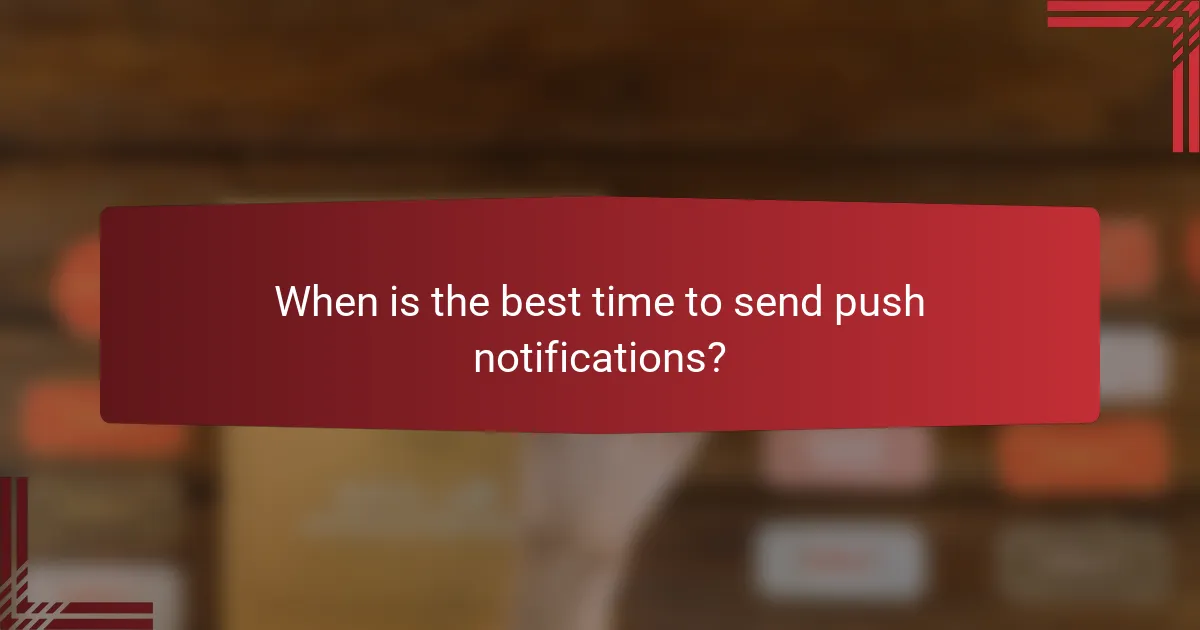
When is the best time to send push notifications?
The best time to send push notifications depends on user behavior, time zones, and specific events. Understanding these factors can significantly enhance user engagement and response rates.
Optimal times based on user behavior
User behavior patterns reveal that push notifications are most effective during specific times of the day. Generally, early mornings, lunch hours, and evenings tend to yield higher engagement rates. For instance, sending notifications around 8 AM or 6 PM can capture users when they are most likely to check their devices.
Additionally, consider the days of the week; weekdays might see different engagement compared to weekends. Testing various times can help identify the optimal windows for your specific audience.
Time zone considerations
Time zone differences can significantly impact the effectiveness of push notifications. Sending a notification at 9 AM in one time zone may reach users at an inconvenient hour in another. To maximize reach, segment your audience based on their time zones and schedule notifications accordingly.
Utilizing tools that allow for time zone targeting can streamline this process, ensuring that messages are delivered at appropriate times for each user group.
Event-triggered notifications
Event-triggered notifications are sent based on specific user actions or significant events. These can include reminders for upcoming appointments, alerts for sales, or notifications for new content. Timing these notifications to coincide with user behavior can lead to higher engagement.
For example, if a user adds items to their cart but does not complete the purchase, sending a reminder notification within a few hours can encourage conversion. Establishing clear triggers and timing for these notifications is essential for maximizing their impact.
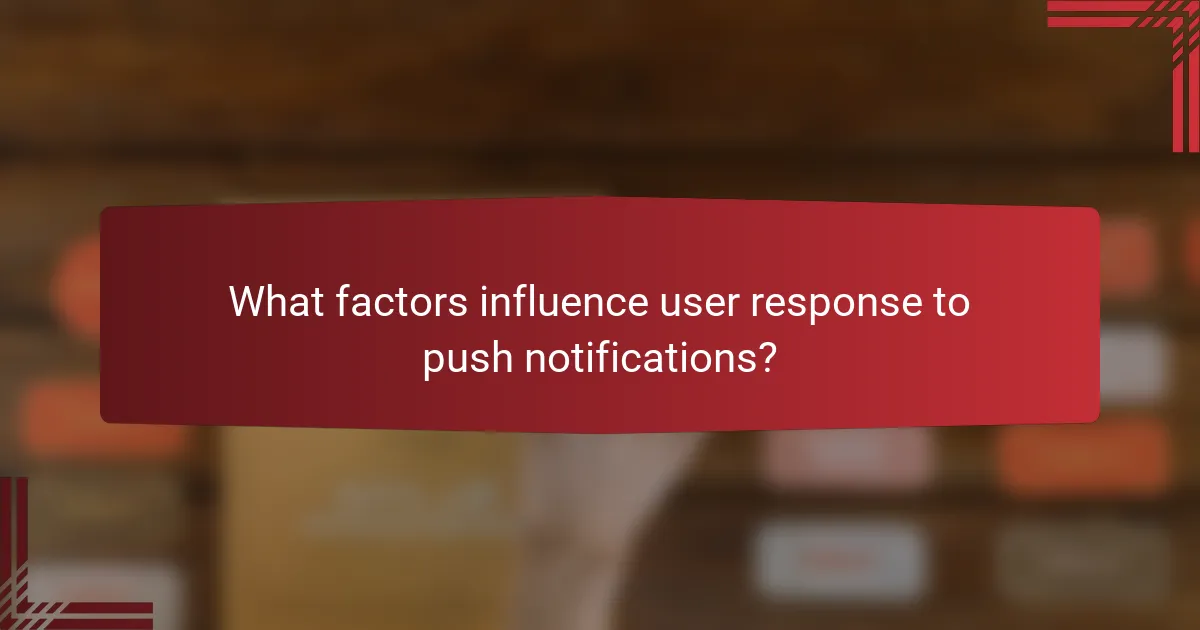
What factors influence user response to push notifications?
User response to push notifications is influenced by several key factors, including message personalization, notification frequency, and content relevance. Understanding these elements can help optimize engagement and improve user experience.
Personalization of messages
Personalized push notifications significantly enhance user engagement. When messages are tailored to individual preferences, behaviors, or demographics, users are more likely to respond positively. For example, a retail app might send a notification about a sale on a product category that a user frequently browses.
To achieve effective personalization, consider using user data to segment your audience. This can include location, purchase history, or browsing behavior. However, ensure that the personalization does not come off as intrusive; balance is key.
Frequency of notifications
The frequency of push notifications can greatly impact user response rates. Sending too many notifications can lead to user fatigue and increased opt-out rates, while too few may result in missed engagement opportunities. Aiming for a moderate frequency, such as a few notifications per week, is often effective.
Establish a clear strategy for notification timing and frequency. Monitor user engagement metrics to find the sweet spot for your audience. A/B testing can also help determine the optimal frequency without overwhelming users.
Content relevance
Content relevance is crucial for ensuring that push notifications resonate with users. Notifications that provide valuable, timely, and contextually appropriate information are more likely to elicit a positive response. For instance, a weather app sending alerts about severe weather conditions is likely to be appreciated.
To maintain content relevance, regularly review user feedback and engagement data. Tailor notifications to current events, user interests, or seasonal trends. Avoid generic messages that do not align with user expectations, as these can lead to disengagement.
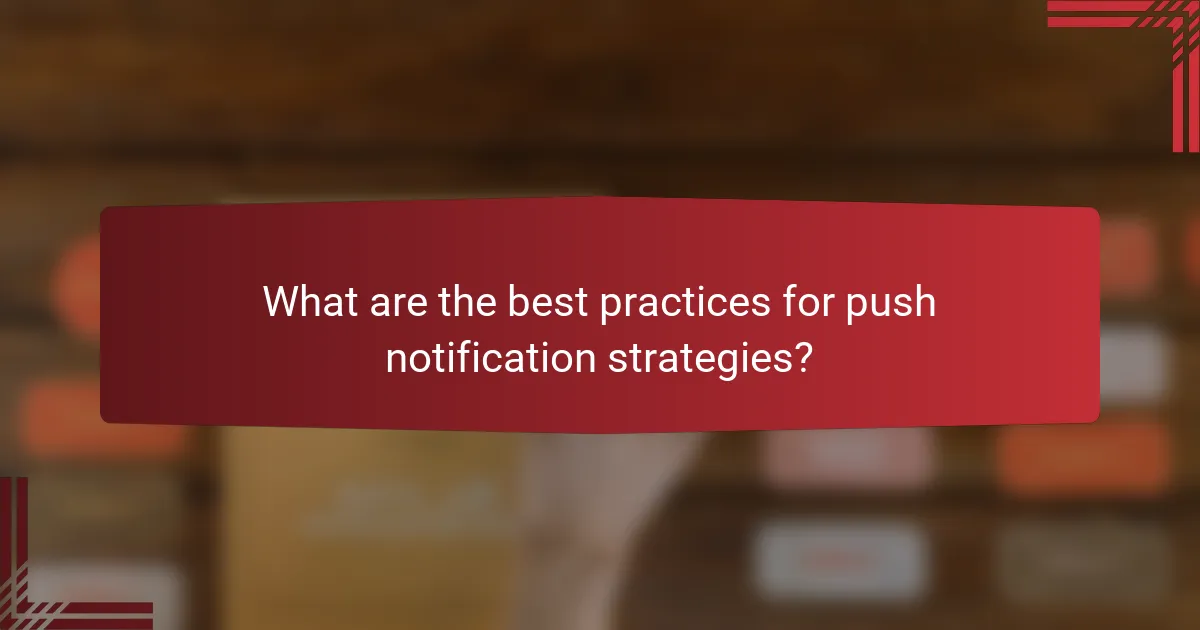
What are the best practices for push notification strategies?
Effective push notification strategies involve understanding your audience, testing different approaches, and ensuring clear communication. By following best practices, you can enhance user engagement and drive desired actions.
Segmentation of audience
Segmenting your audience allows you to tailor notifications based on user behavior, preferences, and demographics. This targeted approach increases relevance, making users more likely to engage with the notifications. Consider segments such as age, location, purchase history, or app usage frequency.
For example, a retail app might send promotions to users who frequently shop but not to those who rarely engage. This ensures that notifications resonate with the intended recipients, improving overall effectiveness.
A/B testing for effectiveness
A/B testing involves sending two variations of a push notification to different segments of your audience to determine which performs better. This method helps identify the most effective messaging, timing, and design elements. Regular testing can lead to continuous improvement in engagement rates.
When conducting A/B tests, consider factors like notification wording, images, and timing. For instance, you might test a notification sent at noon versus one sent in the evening to see when users are more responsive.
Clear call-to-action
A clear call-to-action (CTA) is essential for guiding users on what to do next after receiving a push notification. A strong CTA can significantly increase click-through rates and conversions. Use direct language that prompts immediate action, such as “Shop Now” or “Learn More.”
Ensure that the CTA stands out visually within the notification and is relevant to the content. For example, if the notification promotes a sale, the CTA should lead directly to the sale page, minimizing any friction in the user experience.
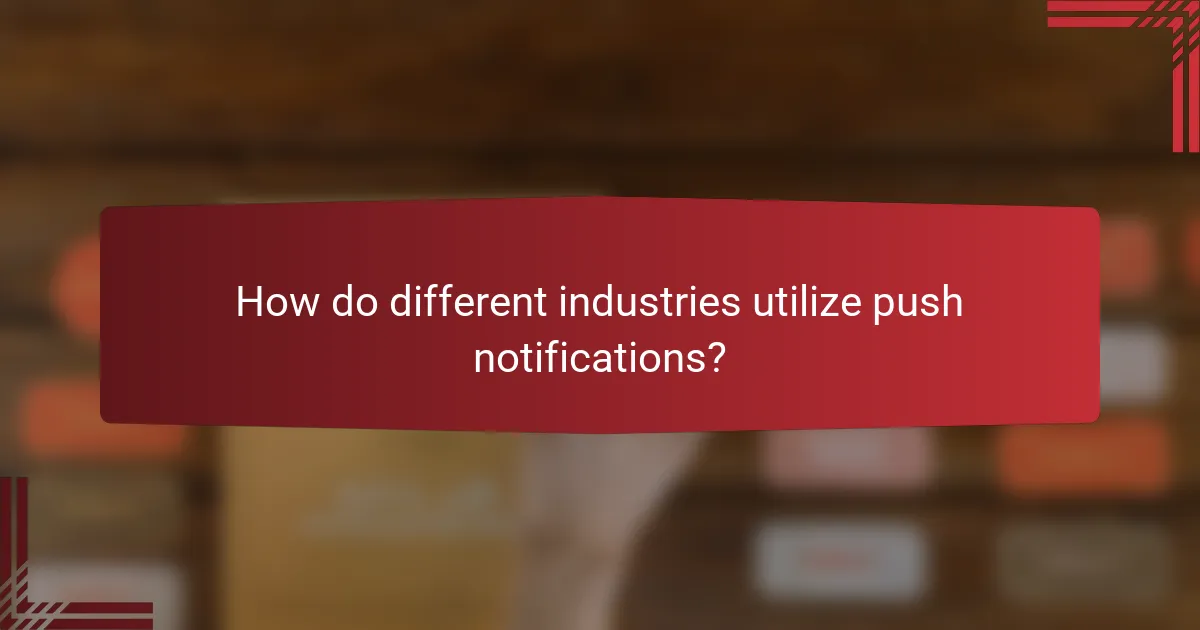
How do different industries utilize push notifications?
Different industries leverage push notifications to engage users, promote products, and deliver timely information. Each sector tailors its approach to meet the specific needs of its audience, enhancing user experience and driving interaction.
E-commerce push notifications
E-commerce businesses use push notifications to alert customers about sales, new arrivals, and personalized recommendations. These notifications can significantly increase conversion rates by prompting users to complete purchases or revisit abandoned carts.
For effective e-commerce notifications, consider timing and content. Sending messages during peak shopping hours or special events can yield better results. A/B testing different messages can help identify what resonates best with your audience.
News and media notifications
News organizations utilize push notifications to deliver breaking news and updates directly to users’ devices. This immediacy keeps audiences informed and engaged, fostering a habit of checking for updates regularly.
To maximize engagement, news outlets should focus on delivering concise, impactful headlines. Users appreciate notifications that provide essential information quickly, so avoid excessive detail. Offering customizable notification settings can also enhance user satisfaction.
Gaming industry notifications
The gaming industry employs push notifications to inform players about new game releases, in-game events, and updates. These messages can drive user retention and encourage players to return to the game regularly.
Timing is crucial in gaming notifications; sending alerts during peak gaming hours can boost engagement. Additionally, personalizing notifications based on player behavior can enhance their effectiveness, making users feel valued and more likely to engage with the content.

What tools are available for managing push notifications?
Several tools can help manage push notifications effectively, allowing businesses to engage users with timely and relevant messages. These tools vary in features, ease of use, and integration capabilities, making it essential to choose one that aligns with your specific needs.
OneSignal
OneSignal is a popular push notification service that offers a user-friendly interface and robust features. It allows businesses to send targeted notifications based on user behavior and preferences, enhancing engagement rates significantly.
With OneSignal, you can segment your audience, schedule notifications, and analyze performance metrics to optimize your messaging strategy. The platform supports web and mobile notifications, making it versatile for different applications.
Consider using OneSignal if you need a comprehensive solution that integrates easily with various platforms and provides detailed analytics to track user responses.
Firebase Cloud Messaging
Firebase Cloud Messaging (FCM) is a powerful tool from Google that enables developers to send notifications to users across Android, iOS, and web applications. FCM is free to use and integrates seamlessly with other Firebase services, making it a cost-effective option for developers.
This tool allows for real-time messaging and supports both upstream and downstream messaging, which means you can send notifications to users and receive responses. FCM also offers features like message targeting and scheduling, which can help improve user engagement.
When using FCM, ensure you familiarize yourself with its integration requirements and best practices to maximize its effectiveness in your push notification strategy.
